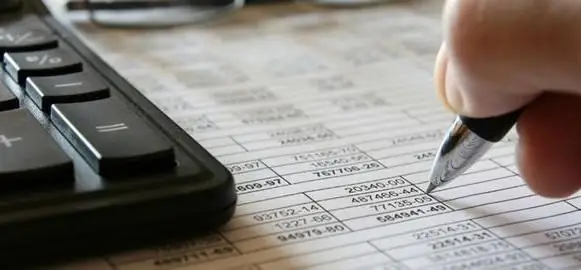2025 Author: Howard Calhoun | [email protected]. Last modified: 2025-01-24 13:10:43
In accordance with PBU 18/02, since 2003, the accounting should reflect the amounts arising from the discrepancy between accounting and tax accounting. At manufacturing enterprises, this requirement is quite difficult to fulfill. The problems are related to the difference in the rules for evaluating finished goods and WIP (work in progress). Let us consider further some features of accounting and tax accounting.

General information
In Ch. 25 of the Tax Code establishes the procedure for evaluating finished products and WIP. It differs significantly from accounting rules. Basic accounting is carried out in accordance with clauses 64 and 59 of the Rules, approved by order of the Ministry of Finance No. 34n of 1998-29-07.
An enterprise can choose the procedure for recognizing administrative and commercial expenses, in accordance with paragraph 9 of PBU 10/99. ATtax accounting (NU) does not have such an opportunity. Article 319 of the Tax Code establishes 3 assessment methods for specific categories of organizations.
Due to this difference between accounting and tax accounting, an enterprise has to review the current period costs, reducing positions for which differences with NU are revealed. The organization can vary the methods of assessment in accounting, trying to adjust it as much as possible to the rules of the Tax Code.
Possible solutions to the problem
It is possible to minimize the difference between accounting and tax accounting by using the write-offs of management and commercial costs directly to the cost of goods sold in the current period. The fact is that the composition of these costs is almost the same as the composition of other indirect costs in NU. By choosing this cost accounting option, a business can solve several problems at once.
First of all, the organization will be able to eliminate temporary differences arising between indirect costs in accounting and tax accounting. At a manufacturing plant in NU, the indirect costs of producing and selling products are fully expensed in the current period. The corresponding provision is fixed by Article 318 of the Tax Code in paragraph 2.
If you do not use the above option, administrative and commercial expenses must be attributed to the costs involved in the formation of the cost of WIP and finished products. At the same time, most of them may not be included in the financial result for the current period. This would create temporary differences.
Secondly, the organization will be able to isolate the area of permanentdifferences in costs included in the cost of goods sold in both accounting and tax accounting. At manufacturing enterprises, most often permanent differences arise when accounting for management and commercial costs, as well as non-production (non-operating, operating) costs.

Third, the organization will be able to exclude from the costs involved in the evaluation of WIP and finished goods, the costs that form permanent differences. The list of direct costs will remain those that cause temporary differences.
Accounting accounts in "1C"
Consider the temporary differences in the remaining production costs accounted for on account. 20, 25, 23, 21.
All these costs are involved in the formation of WIP balances in the current period and the cost of finished products. Meanwhile, they are recognized differently in accounting and tax accounting. In a manufacturing enterprise, these costs are included in direct costs. In tax accounting, they are considered indirect costs. Accordingly, in NU the sums of these costs are not included in the assessment of WIP and finished goods.
The procedure for identifying temporary differences and recording deferred tax assets and liabilities in the relevant accounting accounts will depend on the tax accounting structure of the enterprise. As practice shows, some companies form special NU registers. At the same time, accounting and tax accounting are carried out in parallel.
In other firms, costs are allocated, the recognition procedure for which differs in accounting andWell, directly on the accounts of accounting. This arrangement is used to exclude or add these costs for tax purposes.
Parallel reporting example
Suppose the company produces double-glazed windows. The company evaluates WIP in accounting at the cost of materials and raw materials, and finished products - at the actual production cost.
In accordance with accounting regulations, when determining the cost of finished products, management and commercial costs are not taken into account. They relate to indirect costs and are reflected in accounting in the period of commission.

The table below shows a list of costs and their distribution by groups:
| Costs | Accounting accounts | Accounting group | Tax accounting group |
| Glass | 20 | Straight | |
| Plastic | 20 | ||
| Salary of employees, including UST | 20 | ||
| Depreciation of equipment and other fixed assets | 25 | ||
| Salary for service workers (management, technologists), including UST | 25 | ||
| Services of mini power plant and boiler house | 23 | - | - |
| Energy consumption in shop floor | 23 | Straight | Indirect |
| Power consumption management | 23 | Indirect | |
| Administrative costs | 26 | ||
The procedure for the formation of direct costs when assessing the cost of WIP is established by par. 1 p. 1 319 of the article of the Tax Code.
Depreciation features
Accounting operations related to depreciation allow you to gradually transfer the cost of fixed assets to the cost of finished products.
At the same time, depreciation is not calculated for some objects. The list of such fixed assets, enshrined in regulatory accounting documents, is somewhat different from the list provided for in the NU.
The accounting records do not accrue depreciation for road and forestry facilities, productive livestock, fixed assets of non-profit companies, housing stock facilities. The list is given in clause 17 of PBU 6/01. The amount of depreciation for the specified objects at the end of the year is transferred to an off-balance sheet account. 010.
In NU, the specified fixed assets are not depreciated, subject to a number of conditions. Depreciation is not accrued for road and forestry facilities if they are built using budget funds. Fixed assets of non-profit companies are not depreciated if they are purchased with targeted funds and used for non-profit activities.

General depreciation rules
Depreciation of equipment and other fixed assets in accounting starts from the 1stthe day of the month following the object acceptance period. The corresponding rule is enshrined in paragraph 21 of PBU 6/01.
Calculation thus begins after the accountant makes the entry:
db ch. 01 Cd count. 08 - acceptance of fixed assets for accounting.
In NU, however, depreciation starts from the month following the period the facility is put into service. The corresponding rule fixes paragraph 2 259 of the article of the Tax Code.
If the ownership of the object must be registered, depreciation should be charged in a different order.
In production accounting, depreciation is calculated after the asset is put into operation. This position was expressed by the Ministry of Finance in letter No. 16-00-14/121 dated April 8. 2003 In tax accounting, depreciation calculations are made after the documents are sent for state registration and the funds are put into operation. This is indicated by the provisions of Article 258 of the Tax Code.
Stop accruing depreciation in both accounting and tax accounting at a manufacturing enterprise at the same time - from the 1st day of the month that follows the period in which the asset is depreciated or retired (written off the balance sheet). After that, the object is listed at zero cost.
Calculation methods
There are 4 accrual methods in accounting:
- linear;
- reducing balance;
- proportional to the volume of products produced;
- write-off of cost based on the sum of numbers of years of useful life.
NU uses only 2 methods: linear and non-linear.
For convergence of tax andaccounting, it is advisable for enterprises to apply the linear method.
Meanwhile, if a company chooses a non-linear approach, it can reduce taxable profits by a large amount in the early years of using the OS.
In any case, the method chosen by the enterprise is fixed in the accounting policy and must be applied throughout the operational period.

The service periods of fixed assets are fixed in the Classifier of fixed assets included in depreciation groups. It can also be used for accounting.
If the service life of any product is not specified in the classifier, the company can establish it according to the technical documentation. If there is no period there, you must send a request to the OS manufacturer. The company is not en titled to independently determine the period for using the funds.
Decrease in depreciation rates
In NU, the norm can be halved by:
- Passenger vehicles, the cost of which is more than 300 thousand rubles.
- Passenger minibuses, the price of which is more than 400 thousand rubles.
The management of the enterprise, in addition, has the right to reduce the rate of deductions for any fixed assets at will. The corresponding decision should be fixed in the accounting policy.
Consider an example:
- LLC purchased a passenger car at a price of 600 thousand rubles. (excluding VAT).
- The service life is 48 months. (4 years).
The depreciation rate for the vehicle is:
(1 / 48 months) x 100%=2.083%.
Because the price of the machine is higher300 thousand rubles, the rate can be halved:
2.083% / 2=1.042%.
Monthly depreciation will be:
600 thousand rubles x 1.042%=RUB 6252
Increasing standards
It is provided only for those operating systems that are used in enterprises with multi-shift operation or in a hostile environment. In this case, the norms can be doubled.
Depreciation rates can be increased three times. This possibility applies to settlements on funds leased. However, there is an exception to the rule. In particular, it is not allowed to increase the depreciation rate for fixed assets assigned to groups 1-3, for which depreciation is calculated in a non-linear way.

Consider an example:
- CJSC purchased equipment for production for 200 thousand rubles. (excluding VAT).
- Operation period - 60 months. (5 years).
- Equipment operates four shifts a day continuously.
- Non-linear method is used to calculate depreciation.
The OS norm will be:
(1 / 60 months) x 100%=1.667%.
Since the tool is used in multi-shift mode, the rate can be doubled:
1.667% x 2=3.334%.
The depreciation amount per month will be:
200 thousand rubles x 3, 334%=RUB 6668
Depreciation of used funds
In the case of the acquisition of an object that was in operation, its initial cost is determined in accordance with the contract of sale and based on the costs,related to the purchase. The depreciation calculated by the previous owner is not taken into account.
To calculate depreciation on a used tool, you must first establish the useful life. To do this, you can use the formula:
Term of PI of a used object=Term of PI of a new OS - Time of actual use of the object by the previous owner.

If a company has acquired a tool that has fully worked out its useful life, the company can determine the useful life on its own. It is necessary to establish the period during which the enterprise will be able to operate this facility. The corresponding provision is fixed by paragraph 12 259 of the article of the Tax Code.
Extra
Many organizations have funds acquired before 2002. Depreciation on them, of course, was charged according to the previous rules. But from 1 Jan. 2002, the calculation must be made in the manner prescribed by the Tax Code.
Accordingly, the company must determine the residual value of fixed assets, the remaining period of its useful life, as well as the depreciation rate.
Recommended:
Accounting documents are The concept, rules for registration and storage of accounting documents. 402-FZ "On Accounting". Article 9. Primary accounting documents

Proper execution of accounting documentation is very important for the process of generating accounting information and determining tax liabilities. Therefore, it is necessary to treat documents with special care. Specialists of accounting services, representatives of small businesses who keep independent records should know the main requirements for the creation, design, movement, storage of papers
Personal income tax return for an apartment: procedure, necessary documents and calculation of the amount of tax deduction

Personal income tax deduction for an apartment in Russia raises many questions among the population. For example, where to start this procedure. This article will tell you everything about the refund of personal income tax for real estate, in particular, for an apartment or house
Tax accounting is The purpose of tax accounting. Tax accounting in the organization

Tax accounting is the activity of summarizing information from primary documentation. The grouping of information is carried out in accordance with the provisions of the Tax Code. Payers independently develop a system by which tax records will be kept
Accounting policy for the purposes of tax accounting: the formation of an enterprise accounting policy

A document that defines an accounting policy for tax accounting purposes is similar to a document drawn up according to accounting rules in accounting. It is used for tax purposes. It is much more difficult to draw up it due to the fact that there are no clear instructions and recommendations for its development in the law
For Dummies: VAT (Value Added Tax). Tax return, tax rates and VAT refund procedure

VAT is one of the most common taxes not only in Russia but also abroad. Having a significant impact on the formation of the Russian budget, it is increasingly attracting the attention of the uninitiated. For dummies, VAT can be presented in a schematic form, without going into the smallest nuances

